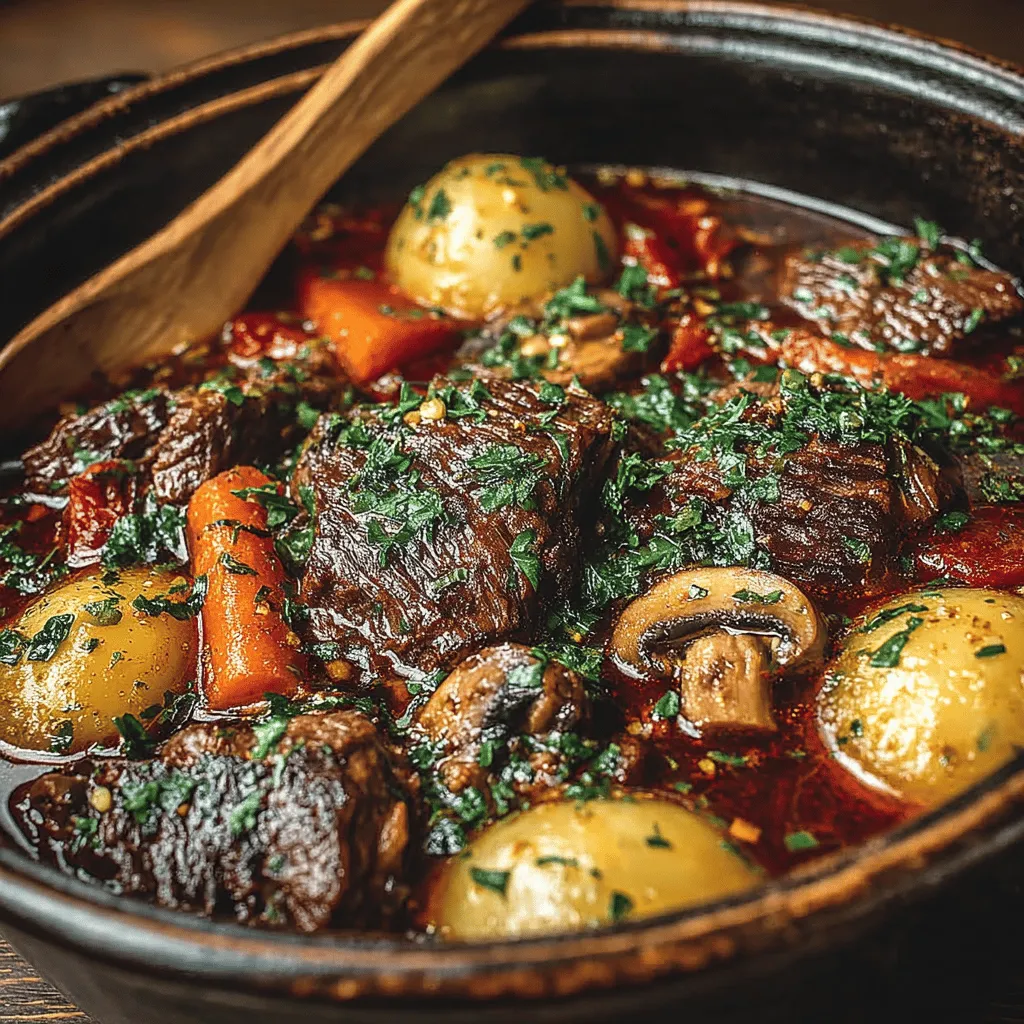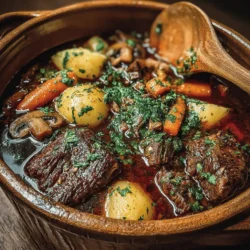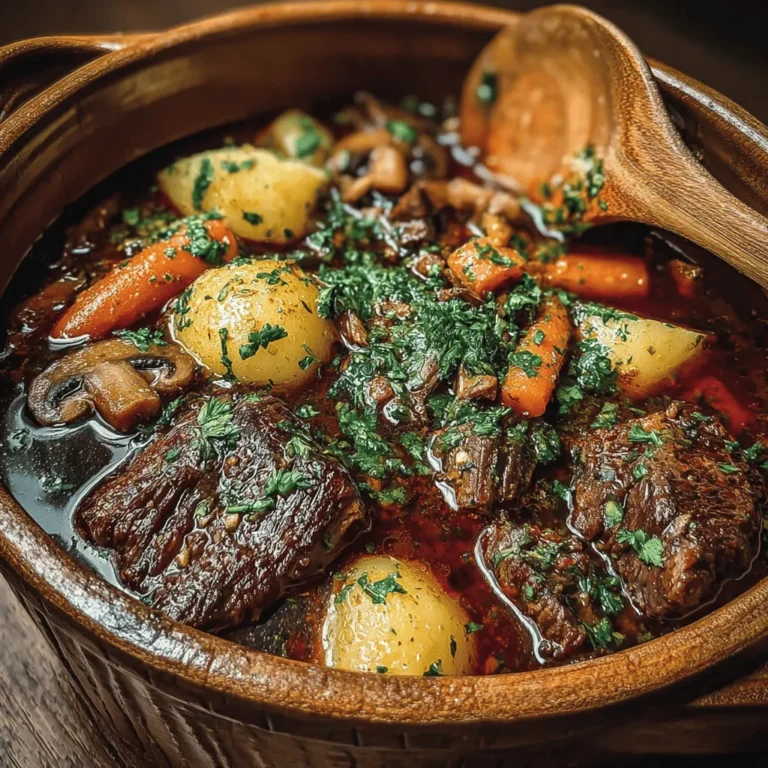Introduction
When the temperature drops and the days grow shorter, there’s nothing quite like a hearty beef stew to warm both body and soul. This classic dish has long been a staple in kitchens around the world, cherished for its comforting qualities and deep, rich flavors. The beauty of beef stew lies in its simplicity, yet it offers a depth that can only be achieved through the careful selection of ingredients and techniques. At the heart of our recipe is the combination of tender beef, robust vegetables, and a generous splash of red wine, all simmered together to create a nurturing meal that brings people together.
The use of red wine in beef stew is not merely for a touch of elegance; it serves a crucial role in flavor enhancement and tenderizing the meat. The acidity in red wine breaks down the tough fibers in the beef, resulting in a tender, melt-in-your-mouth experience. Coupled with aromatic herbs, this stew transcends the ordinary, delivering a dish that feels special yet remains accessible for the home cook.
Originating from various culinary traditions such as French (Boeuf Bourguignon), Irish, and even Italian, beef stew has evolved over time, with each culture adding its unique flair. Today, we’ll explore a version that highlights the rich, savory notes of red wine and a carefully selected array of herbs, making it a true comfort food classic for any occasion.
Understanding the Ingredients
To create a memorable beef stew, understanding the key ingredients is essential. Each component plays a vital role in building the flavor profile and ensuring a satisfying texture.
Beef Chuck: The Ideal Cut for Stews
When it comes to selecting beef for stew, beef chuck is often considered the gold standard. This cut comes from the shoulder area of the cow and is known for its marbling and connective tissue. During the slow cooking process, the collagen in the beef breaks down, resulting in a tender piece of meat that absorbs the flavors of the broth and seasonings. Choosing high-quality beef chuck will enhance the overall taste and texture of your stew, making it a rich and hearty dish.
The Role of Vegetables
A well-rounded beef stew features a medley of vegetables that contribute both flavor and nutrition. The classic combination typically includes:
– Onions and Garlic: These two aromatics form the flavor base of the stew. Sautéing them releases their natural sweetness and depth, setting the stage for the rest of the ingredients.
– Carrots: Adding a touch of sweetness and color, carrots also provide a pleasant crunch that contrasts beautifully with the tender beef.
– Potatoes: A comforting addition, potatoes absorb the rich flavors of the broth while adding a hearty substance to the dish. They become creamy as they cook, creating a satisfying mouthfeel.
– Mushrooms: Their umami richness enhances the overall depth of flavor, making them a perfect companion to beef.
Importance of Red Wine in Cooking
Red wine is a transformative ingredient in this stew, serving multiple purposes. Not only does it provide a vibrant color and complex flavor, but it also helps to tenderize the meat as it cooks. The alcohol evaporates during the simmering process, leaving behind the rich notes of dark fruit, spice, and earthiness that elevate the dish. When choosing a red wine for cooking, opt for a dry variety such as Merlot or Cabernet Sauvignon—these wines will impart the most flavor without adding excessive sweetness.
Herbs and Spices
Herbs are pivotal in developing the aromatic character of the stew. Our recipe calls for thyme, rosemary, and bay leaves, each contributing its unique profile:
– Thyme: With its earthy and slightly minty flavor, thyme is a classic herb for stews. It pairs beautifully with both beef and red wine, enhancing the overall taste.
– Rosemary: This herb adds a distinct pine-like flavor that complements the richness of the beef, providing a fragrant note that lingers in the background.
– Bay Leaf: Often used in slow-cooked dishes, bay leaves impart a subtle complexity, rounding out the flavors without overpowering the other ingredients.
Broth and Tomato Paste: Creating a Rich Base
A beef stew wouldn’t be complete without a robust broth and a touch of tomato paste. The broth serves as the foundation, enveloping all the ingredients and allowing them to meld together. Whether you opt for homemade beef broth or a high-quality store-bought variety, it should be rich and flavorful.
Tomato paste adds both acidity and depth, balancing the richness of the beef and wine. It also contributes a lovely color to the stew, making it visually appealing.
Preparation Techniques for the Perfect Beef Stew
Achieving the perfect beef stew involves more than just gathering ingredients; it requires careful preparation techniques that enhance the dish’s flavor and texture.
Importance of Searing Meat
Searing the beef is a crucial first step in developing a rich, deep flavor. By browning the meat in a hot pan, you create a caramelized crust that locks in juices and adds complexity to the dish. This Maillard reaction is what gives the stew its savory depth, making it essential to take the time to sear the beef properly before moving on to the next steps.
Sautéing Vegetables
Once the beef is seared to perfection, the next step is to sauté the vegetables. This technique involves cooking the onions and garlic until they are translucent and fragrant, followed by adding the other vegetables. Sautéing not only enhances the flavors but also ensures that the vegetables maintain some texture throughout the slow cooking process.
Deglazing
After sautéing, the pan will likely have browned bits stuck to the bottom—this is where the flavor resides. Deglazing involves adding a splash of red wine (or broth) to the pan and scraping up those bits. This step is vital for building the stew’s flavor, as it incorporates all the delicious remnants from the searing process into the final dish.
Simmering for Tenderness
The final step in preparation is to let the stew simmer gently. This slow cooking process allows the flavors to meld and the beef to become tender. It’s important to monitor the temperature; a low and slow approach will yield the best results, breaking down the tough fibers in the meat while ensuring that the vegetables don’t turn to mush.
Step-by-Step Recipe Guide
Now that we understand the importance of each ingredient and preparation technique, let’s dive into the step-by-step guide for our Hearty Beef Stew with Red Wine and Herbs.
Searing the Beef
1. Prepare the Beef: Cut about 2-3 pounds of beef chuck into 1.5-inch cubes. Pat the pieces dry with paper towels, then season generously with salt and pepper.
2. Heat the Pan: In a large Dutch oven or heavy-bottomed pot, heat a couple of tablespoons of olive oil over medium-high heat until shimmering.
3. Sear the Meat: Working in batches, add the beef cubes to the hot oil, ensuring not to overcrowd the pan. Sear each side for 4-5 minutes until a deep brown crust forms. Remove the beef and set aside.
Sautéing the Aromatics
4. Cook the Aromatics: In the same pot, reduce the heat to medium and add the diced onions and minced garlic. Sauté for about 2 minutes, or until the onions are translucent.
5. Add Remaining Vegetables: Next, stir in the carrots, potatoes, and mushrooms. Sauté for another 5-7 minutes until they begin to soften.
Deglazing the Pot
6. Deglaze: Pour in a cup of red wine, using a wooden spoon to scrape the browned bits from the bottom of the pot. Allow the wine to simmer for a few minutes, reducing slightly.
Building the Stew
7. Combine Ingredients: Return the seared beef to the pot, along with the herbs (thyme, rosemary, and bay leaf), beef broth, and a couple of tablespoons of tomato paste. Stir to combine.
8. Simmer: Bring the stew to a gentle boil, then reduce the heat to low. Cover and let it simmer for at least 2 hours, stirring occasionally, until the beef is tender and the flavors have melded beautifully.
In the next part of this article, we will explore the finishing touches and serving suggestions for this Hearty Beef Stew with Red Wine and Herbs, ensuring that your culinary experience is as satisfying as it is delicious. Stay tuned for the completion of this classic dish!

Adding and Cooking Vegetables: Layering Flavors for Depth
Once your beef is browned to perfection, it’s time to build the flavor foundation of your hearty beef stew by adding vegetables. The traditional mirepoix, consisting of onions, carrots, and celery, is an excellent starting point for any stew. Begin by adding your chopped onions to the pot. Sauté them until they become soft and translucent, approximately 5-7 minutes. This process releases their natural sugars and forms the base of your stew’s flavor.
Next, add diced carrots and celery. These vegetables not only add sweetness but also a lovely texture to your stew. Continue cooking them for another 5 minutes, allowing them to soften slightly. At this stage, feel free to incorporate other vegetables such as parsnips, potatoes, or bell peppers. Each addition contributes unique flavors and enhances the overall complexity of the dish.
Don’t forget to season the vegetables lightly with salt and pepper as they cook; this helps draw out moisture and intensifies their flavors.
Deglazing with Wine: Techniques for Scraping and Incorporating Fond
After the vegetables have softened, it’s time to deglaze the pot. This technique is crucial as it helps incorporate the flavorful brown bits, known as fond, that have developed on the bottom of the pan during the browning process. Pour in your chosen red wine—about a cup should suffice.
As the wine hits the hot pot, it will begin to bubble and steam. Use a wooden spoon to gently scrape the bottom of the pot, loosening those delicious browned bits. Not only does deglazing add depth to your stew, but it also helps to mellow the acidity of the wine, infusing the dish with rich, complex flavors.
Allow the wine to simmer for about 3-5 minutes, letting it reduce slightly. This reduction concentrates the flavors and helps to meld everything together before you add the remaining ingredients.
Combining Ingredients: Achieving the Right Stew Consistency
Now that you’ve deglazed the pot, it’s time to combine all the ingredients for your beef stew. Return the browned beef to the pot, along with any accumulated juices. Add your beef broth or stock; this should generally be enough to cover the meat and vegetables by about an inch. The right broth-to-solid ratio is crucial for achieving the desired stew consistency—thick and hearty without being overly soupy.
At this point, stir in your herbs, such as fresh thyme, rosemary, or bay leaves. Dried herbs can also be used; just be mindful of the quantities, as they are more concentrated. If you want to elevate the flavor even further, consider adding a spoonful of tomato paste or Worcestershire sauce, as these will deepen the umami notes in your stew.
Bring the mixture to a gentle boil, then reduce the heat to low. Cover the pot with a lid, allowing it to simmer. This slow cooking process will enable the flavors to develop further, creating a robust and hearty stew.
Simmering Process: How to Check for Doneness and Tenderness
The simmering process is where the magic happens. Allow your beef stew to cook for at least 1.5 to 2 hours on low heat, stirring occasionally to prevent sticking. The low and slow method is essential for breaking down the tough fibers in the meat, resulting in tender, melt-in-your-mouth beef.
To check for doneness, use a fork to test the meat. It should easily shred apart, indicating that it’s cooked through and tender. Additionally, the vegetables should be soft but not mushy. If they disintegrate, they’ve been overcooked. If the stew seems too thick during cooking, you can always add a little more broth or water to reach your desired consistency.
Flavor Enhancements and Variations
Suggestions for Alternative Vegetables and Herbs for Customization
One of the great things about beef stew is its adaptability. Feel free to get creative with your vegetable choices. Consider adding green beans, peas, or even sweet potatoes for a different flavor profile. You can also experiment with herbs; while thyme and rosemary are classic choices, consider adding fresh parsley or dill for a fresh twist.
Options for Different Types of Red Wine: How They Affect Flavor
When it comes to red wine, the kind you choose can dramatically influence the flavor of your stew. A full-bodied red wine, such as Cabernet Sauvignon or Merlot, will impart a rich depth, while a lighter Pinot Noir may provide a more delicate flavor. Avoid overly sweet wines; instead, opt for dry reds that will enhance the savory elements of the dish.
Incorporating Other Proteins: Variations with Chicken or Plant-Based Options
If beef isn’t your preference, you can easily adapt this recipe for other proteins. Chicken thighs can be used instead of beef for a lighter version. Simply adjust the cooking time to about 45 minutes to 1 hour, as chicken cooks more quickly than beef.
For a plant-based option, consider using mushrooms or lentils as the base. Substitute the beef with hearty vegetables like eggplant or jackfruit, and use vegetable broth instead of beef broth. The cooking process remains the same; just keep an eye on the tenderness of your plant-based ingredients.
Adapting the Recipe for Slow Cookers or Instant Pots
If you’re short on time, adapting this beef stew recipe for a slow cooker or Instant Pot is easy. For a slow cooker, follow the same initial steps of browning the meat and sautéing the vegetables, then transfer everything to the slow cooker. Cook on low for 6-8 hours or high for 3-4 hours.
For an Instant Pot, brown the meat and sauté the vegetables using the sauté function. Then, add the wine and scrape the fond before adding the broth and other ingredients. Seal the lid and cook on high pressure for about 35 minutes. Allow the steam to release naturally for about 10 minutes before manually releasing any remaining pressure.
Serving Suggestions
Ideal Side Dishes to Accompany Beef Stew
Beef stew is a hearty meal on its own, but it pairs beautifully with various side dishes. Consider serving a fresh green salad with a light vinaigrette to balance the richness of the stew. A classic Caesar or mixed greens salad can provide a refreshing contrast.
Bread Options: Crusty Baguette or Soft Rolls
Bread is a must-have with beef stew, perfect for soaking up the savory broth. A crusty baguette or some soft rolls are excellent choices. You can also try baking some homemade biscuits for a comforting addition.
Salads That Complement the Stew’s Richness
To complement the stew, consider a salad that includes fresh ingredients like arugula, cherry tomatoes, and cucumbers. A sprinkle of feta cheese or nuts can add an extra layer of flavor and texture.
Presentation Tips for a Visually Appealing Meal
When serving your beef stew, presentation matters. Use wide, shallow bowls to showcase the ingredients. Garnish with freshly chopped parsley or thyme to add a pop of color. A drizzle of olive oil over the top can also enhance the visual appeal, making the dish look as inviting as it tastes.
Nutritional Information
Overview of the Nutritional Benefits of the Ingredients Used
Beef stew is not only delicious but also packed with nutrients. The beef provides a rich source of protein, iron, and B vitamins, essential for energy and overall health. The vegetables contribute dietary fiber, vitamins A and C, and antioxidants, promoting a balanced diet.
Caloric Breakdown Per Serving and Health Benefits of a Hearty Stew
On average, a serving of beef stew contains about 350-400 calories, depending on the serving size and ingredients used. This makes it a hearty yet manageable meal option. The balance of protein, healthy fats, and carbohydrates makes it a satisfying choice for any time of the year.
Discussion on the Balance of Macronutrients in the Meal
This stew offers a well-rounded balance of macronutrients. The protein from the beef supports muscle health, while the carbohydrates from the vegetables provide energy. If you choose to serve it with bread, you’ll additionally enhance the carbohydrate content, making it a fulfilling meal.
Conclusion
Beef stew is the epitome of comfort food, offering warmth and satisfaction in every bite. Its versatility allows for countless variations, ensuring that you can adapt the recipe to suit your taste preferences or dietary needs. Whether you’re cooking for a family gathering or a cozy night in, this hearty beef stew with red wine and herbs is sure to please.
Cooking is not just about the ingredients; it’s about the joy of sharing and creating memories with loved ones. We invite you to explore different variations of this classic dish, making it your own and enjoying the process along the way. So gather your ingredients, roll up your sleeves, and celebrate the comforting nature of a homemade beef stew.


